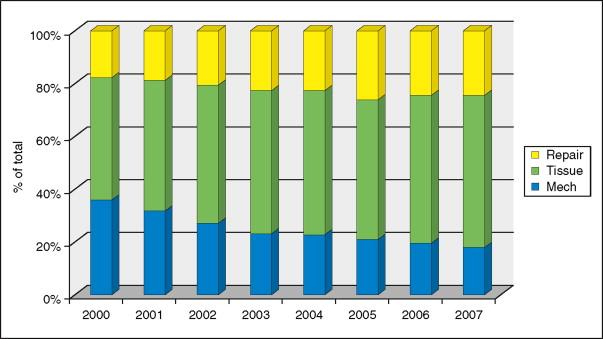Physical Address
304 North Cardinal St.
Dorchester Center, MA 02124
Surgeons who prefer valve replacement over valve reconstruction often claim that they are uncertain about the long-term benefits of valve reconstruction. Another assertion is that failure following valve repair is generally attributed to the surgeon, whereas a complication after valve replacement can more easily be blamed on the valve itself. Surgeons who are doubtful about their expertise in performing a successful valve repair procedure prefer replacing the valve, citing the fashionable “principe de précaution” *
* See Glossary .
as the basis for their decision, which actually does not always benefit the patient. These arguments have been ruled out by numerous publications showing the excellent results of reconstructive valve surgery in patients who have been followed up to 25 years. In addition, recent guidelines from ad hoc committees have emphasized the general consensus that valve repair is superior to valve replacement provided that it is performed by an expert surgeon using reconstructive valve techniques. However, even today, for a given patient the chance of benefiting from an efficient valve reconstruction varies significantly from surgeon to surgeon and from institution to institution; some centers boast a 90% valve repair rate while others perform almost exclusively valve replacements. Low-volume centers have lower repair rates, and low repair rates have a direct impact on the referral of valvular patients. A lack of expertise in mitral valve reconstruction rather than knowledge of the complexity of lesions is the reason for the majority of mitral valve replacements. In this closing chapter, we address the conditions that are necessary to acquire this expertise and to develop a program of reconstructive valve surgery using a step-by-step approach.
Although the surgeon is at the center of this program, his/her efforts would be futile without the help and support of a team of specialists comprising cardiologists, echocardiographers, and anesthesiologists.
Cardiologists in the past used to limit their role to referring a patient for a “surgical indication” regardless of the type of disease or the patient's condition. No particular surgical approach, technique or valvular prosthesis was recommended. Today, with accurate knowledge of the different surgical alternatives and more attention being paid to the patient's preference, cardiologists are more deeply involved in the decision-making process. They give a growing importance to “nonthrombogenic valve surgery,” which includes valve repair and tissue valve, namely valvular bioprostheses ( Fig. 40-1 ). The reason is that these techniques do not require specific anticoagulation therapy and therefore ensure a better quality of life. The increase in nonthrombogenic valve surgery is due in a large part to the continuous progress in glutaraldehyde tissue processing of bioprosthetic valves and in part to the development of reconstructive techniques for mitral and tricuspid valves.

Progress in chemical processing of bioprosthetic valves has been such that, in the aortic position, these valves are now used more frequently than mechanical valves. The indication of valve reconstruction techniques necessitates that cardiologists obtain from each patient a comprehensive clinical history and an accurate evaluation of symptoms in order to assess the dysfunction and determine the optimal time for surgery. Another major change in the cardiologist's role has been the referral of asymptomatic patients for valve reconstruction. Since a valve reconstruction can only be envisioned if the surgical team is able to guarantee its feasibility, a close relationship between cardiologists and surgeons is a key issue. Patients with a low likelihood of repair, attributable either to the complexity of the valvular lesions or to the limited experience of the surgical team, should be informed that they may benefit from a valve reconstruction if referred to a more expert group.
Echocardiographers play a major role. They not only complete a comprehensive analysis of the etiology, the lesions, and the dysfunction of the valve before surgery, but they also are instrumental in helping the surgeon to select the most appropriate technique. Here again, it is important for both echocardiographers and surgeons to communicate effectively, to use the same terminology, and to discuss every case extensively. Today, one cannot imagine a surgical group without the availability of echocardiography in the operating room. Whether two-dimensional or three-dimensional data are used, they should enable: classification of valve dysfunction into one of the four functional groups, localization of the predominant dysfunction, determination of the size of ring to be selected, and even prediction of the type of reconstructive technique that will be used. Like the surgeon who should learn to interpret the echocardiographic images, the echocardiographer should take advantage of a direct view of the valve during the surgery in order to confront his or her findings. Once extracorporeal circulation has been discontinued, transesophageal echocardiography is critical to recognize an occasional residual valvular dysfunction as well as its mechanism and localization. The echocardiographer then has the important responsibility of recommending a second look if the result is not fully satisfactory.
Anesthesiologists use more and more transesophageal echocardiography in their daily practice to assess global and segmental myocardial function. They also use it to optimize ventricular filling, to verify the completeness of de-airing, and to evaluate the efficacy of occasional inotropic drugs and intraaortic balloon counterpulsation. In many institutions, they perform valve analysis themselves and assess the result of the reconstructive valve operation.
Surgeons , for their part, should be psychologically and technically prepared to perform a valve operation rather than a predetermined valve replacement. They should have a clear perception of their limitation in valve reconstruction. They should be able to take responsibility for the decision of whether or not they have the expertise for the valve repair. Whenever necessary they should seek the assistance of a more experienced colleague. If this is not possible, they should improve their own expertise by taking advantage of one or several means of transfer of knowledge.
Become a Clinical Tree membership for Full access and enjoy Unlimited articles
If you are a member. Log in here